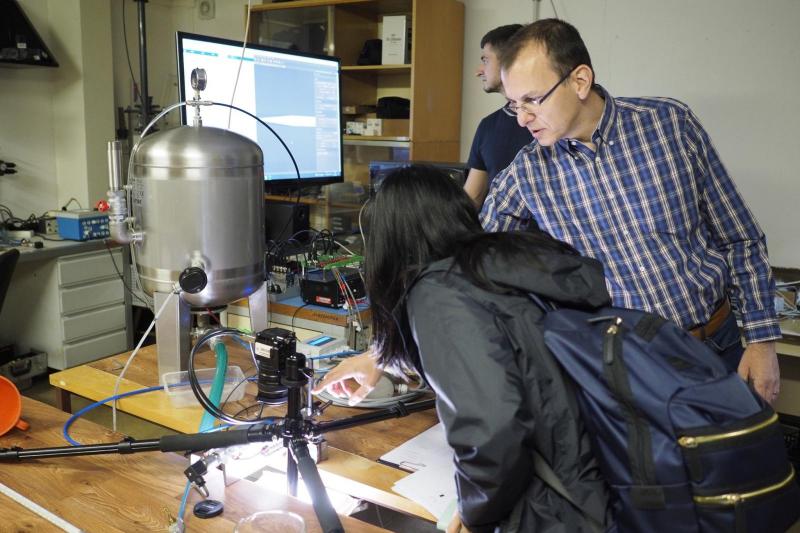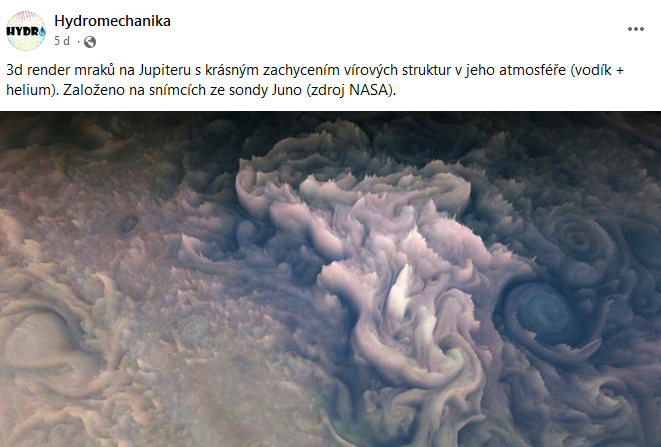People
The beauty of flow is all around us, says @HydromechanikaVUT

Dams, clouds, airplanes, animals, waves... This is just a short list of topics on which researcher and teacher Pavel Rudolf illustrates the beauty of hydromechanics. His Facebook profile has over seven and a half thousand followers. Among them are students, graduates, but also people who have nothing to do with BUT (Brno University of Technology), they are simply fascinated by nature. How did it happen that the lover of instability built such a stable fan base?
Why did you decide to start a popularization profile on Facebook?
A couple of years ago I noticed that popularization sites started to appear on the net. I think one of the first ones at the Faculty of Mechanical Engineering had professor Josef Štětina (it is a very popular page Thermomechanics, ed. note). That inspired me. The students were already online a lot at that time, so I thought, why not supplement the teaching in this direction? My ambition was not to put heavy science and equations in there, but rather to get them excited so that they would be interested in looking up the information themselves. That's why I focused on the interesting things from the beginning.
Fluid mechanics is all around us, which gives me a big advantage. I can show things we see every day, like on the way to school when there are nicely shaped clouds in the sky. For example, one particular shape is created when there are two opposing wind currents in the sky, creating what is known as the Kelvin-Helmholtz instability, which creates curls in the clouds. And this has many other implications, including technical ones, because similar phenomena also occur in water turbines, where they are undesirable. However, the concepts are all around us, it's just a matter of connecting the phenomena in nature with machines and technology in general.
Okay, but you also had the “flow” of the flock of sheep into the fold in one post. Are we still talking about fluid mechanics?
Basically, it is also about particle flow. The equations we use to describe the flow are very similar to the equations you would get from, for example, observing the flow of cars at an intersection. Similarly with the sheep, the laws of mechanics are still the same.
You post quite often, and have for many years. Where do you get your inspiration?
I read, I watch, I occasionally think of something and mostly I get inspired by other popularizers. Nowadays, many people send me interesting videos, or – and I'm doubly happy about this – something that they have photographed themselves: for example, that they noticed interesting clouds on the way back from the halls, or that they took a picture of a nice whirlpool in a stream somewhere on a hike.
It happens to you that during a lesson a student says: “I know that, I saw that on Facebook”?
Rather, I've been getting questions about whether what's on Facebook is enough for the exam :)
Is that enough?
No, of course it's not enough.
Anyway, you have an admirably large audience. Over seven and a half thousand followers is not much less than the faculty-wide site has.
It is true that when the semester in which I teach Hydromechanics begins, I see my followers increase. And a quite a lot of graduates follow me. About four years ago, however, I noticed a breakthrough, when a lot of people started to follow me who have nothing to do with BUT at first sight, they are just interested in science and nature. From the feedback, I'd say that's almost half of my audience today. A lot of them write to me: “It's a pity I didn't know one could study this at the BUT.” As long as the site fulfils this popularization purpose and shows the beauty of flow mechanics and awakens people's interest in this field, I will be satisfied.
I can't help to ask, how much time does it cost you to manage your profile?
Surprisingly a lot. It's not easy to condense interesting information into a few sentences, and it's not easy to make a post attractive. Sometimes I have to study the topic and understand it properly, because there are questions to the posts, which I try to answer. Plus, I never just copy someone else's content. When I get inspired, it's usually just by a topic, to which I then create my own content. I post when time allows, but I try to make sure that in the week following the lecture there is always a topic that complements or expands on the lecture. And of course I try not to repeat myself, ideally every post is original.
Which type of posts are the most successful?
I can't quite say, but I like things where you encounter fluid mechanics in everyday life. Like the aforementioned clouds. Or what you have in your kitchen, like non-Newtonian liquids like honey, batter, eggs. Just stuff that anyone can touch.

Have you considered expanding to other networks? After all, Facebook is slowly going out of fashion.
I deal with this issue a lot. My kids tell me I'm a boomer for doing Facebook. For now, I'm pulling it out because I already know how to work with it and as long as so many people are interested, it would be a shame to stop. But since last year, I have a group of doctoral students who take care of Instagram.
What are your favourite phenomena from hydromechanics?
Instabilities. The aforementioned Kelvin-Helmholtz instability or the Kármán vortex path are my favourites. I have a lot of posts about them on Facebook as well. And it always makes me happy when someone sends me a picture of themselves capturing them.
(ivu)
When design helps. With the design of a dog wheelchair, the student succeeded in an international competition
Česká Hlavička awardees with a passion for engineering
The market was lack of clothing for tall people, so Radek Pilař started sewing his own
Software as a bachelor thesis helps with soil erosion research
The king of cycling Jakub Mašek got an internship at the European space agency